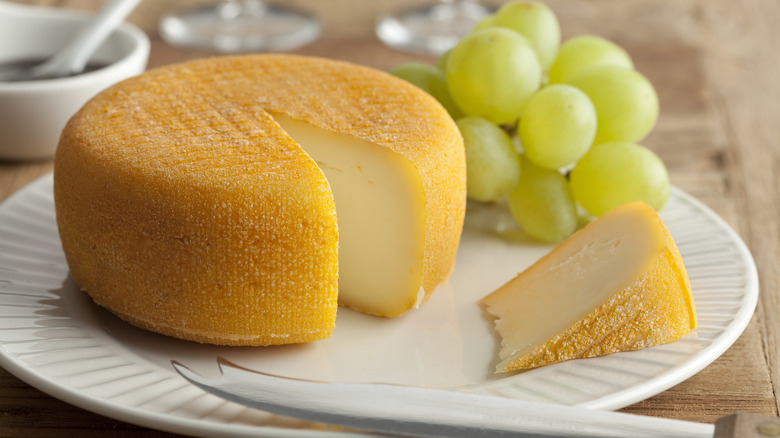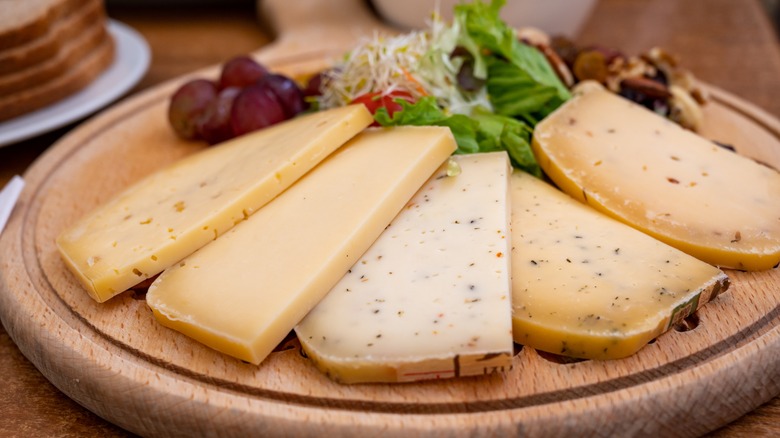The Well-Traveled History Of Port Salut Cheese
What do the words monastic, Trappist, and abbey have in common with gastronomy? A lot, when it comes to cheese. Centuries-old tradition cloaked in old-world mystique once created a clandestine culinary specialty known as monastic or abbey cheeses, a practice that continues to this day.
Depending on where they're crafted and whose hands carry out the recipes, they also answer to names such as monk or Trappist cheeses, named for the Trappist order of monks (and sometimes Trappestine nuns) who made them as far back as the 18th century, according to Le Trappiste Brugge.
The tradition has become more mainstream and even gravitated to mass production in European or North American factories, but at least one Trappist cheese still employs master craftsmen who mostly adhere to the original recipe. That would be Port Salut, a semi-soft creamy cheese from the Loire Valley of France.
Trappist monks from the Abbaye du Port du Salut, also known as the Abbey of Notre-Dame du Port du Salut (via Cheese.com), created the proprietary cheese in the early 1800s. Production remained on the Abbaye grounds for almost 200 years — but the recipe itself had a penchant for travel, slightly shedding its secret shroud along the way.
Port Salut cheese traveled from France to Hungary to North America
Though firmly rooted in the Loire Valley, the process of making Port Salut cheese actually sprang from a period of displacement after the French Revolution, when monks were forced in the late 1700s to leave France for life in Switzerland, states New England Cheesemaking.
To support themselves, the monks learned Swiss artistic methods of making cheese, eventually bringing those skills back to France in 1815. After cultivating their own recipes and cheesemaking styles, the Port Salut fromagerie empire was born within the monastery.
But, the secrets didn't cluster solely within the walls of the Port du Salut monastery. The monks graciously shared their recipe and Trappist techniques with abbeys, monasteries, and convents throughout France. From there, it traveled to Hungary, various European countries, and eventually to North America, picking up regional nuances as it slid across the continents, notes Culture.
One notable French derivative of Port Salut cheese goes by the name Saint-Paulin, produced extensively in France's Bretagne and Maine regions using monastic and industrial processes, per Fromages.com. But even this version has journeyed throughout the world, taking root in artisan cheese enterprises from Brazil to New Zealand, reveals Cook's Info.
Cheese-making the Port Salut way
Though versions of France's famous Trappist cheese now exist across the globe, the original Port Salut carries the monastic mystique born from centuries of artisan cheese crafting. An identifying feature of Port Salut is the colorful yellow/orange rind, born from the original technique of brine washing that involves B. linens bacteria, states New England Cheesemaking.
This also produces special ripening enzymes for the characteristic soft, creamy Port Salut texture. A series of salty washes nudges the enzymes toward the cheese's center, breaking down proteins, reducing acidity, and saturating the cheese with the well-known, beloved flavor. As for the aroma, Port Salut lies within the "stinky cheese" category due to the bacteria, according to igourmet. But the distinct ripening process of this particular Trappist cheese gives it a gentler smell.
This classic monastic cheese identifies strongly with its French abbey origins, but the well-traveled wheel-shaped Port Salut keeps rolling across the continents. You'll find it gracing upscale cheese and charcuterie boards in trendy cafés, sleek restaurants, and home dinner parties. If you're brave enough to extend the entrepreneurial journey of Port Salut cheesemaking into your own kitchen, Culture provides a simulated home version of the revered soft-cheese recipe.


